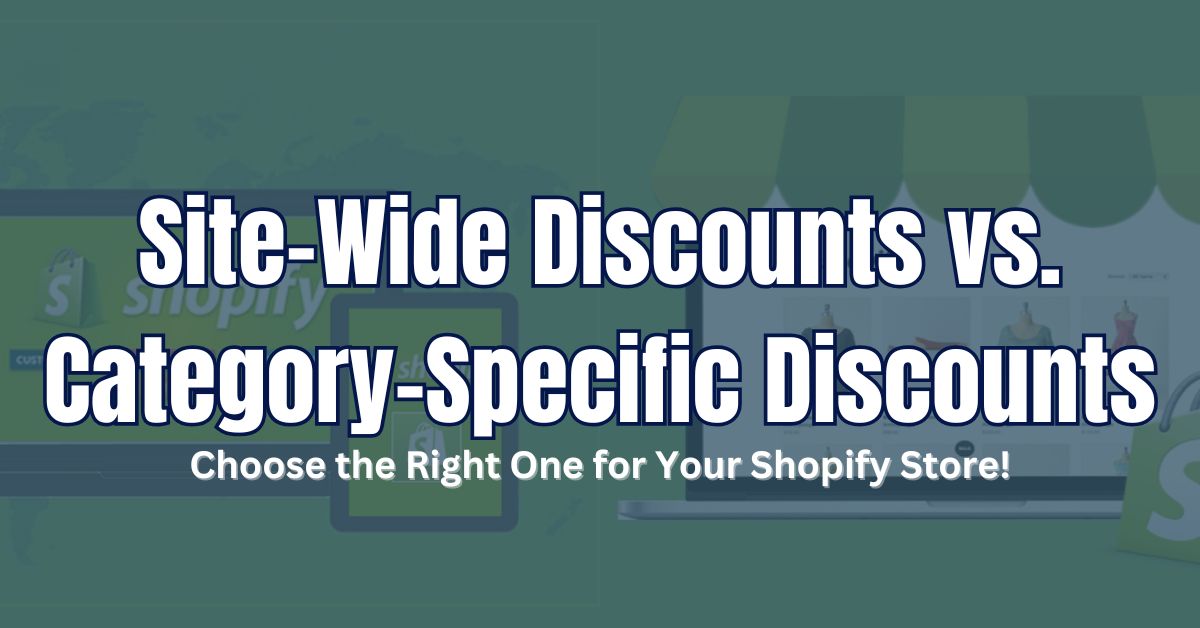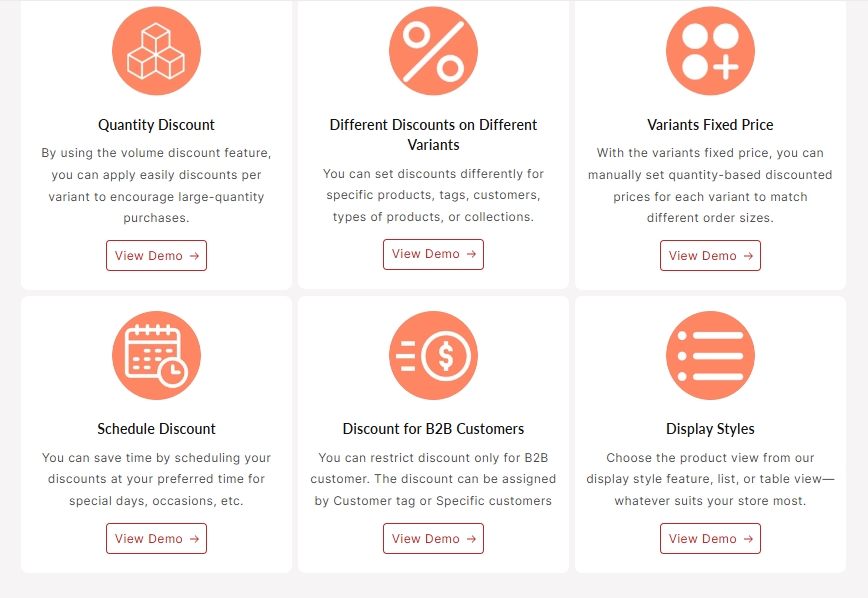
Are you confused between Site-Wide Discounts and category-specific Discounts, or what kind of discount should you offer in your Shopify store?
Site-wide discounts offer store-wide discounts and attract a larger audience. Meanwhile, category-specific discounts apply on specific products to target specific goals.
We know it’s important to offer discounts on your Shopify store. In fact, 60% of American shoppers won’t buy until they get discounts or offers on Shopify. That’s why, as a store owner, choosing the right discount method makes all the difference in your store’s success.
In this article, we’ve discussed site-wide discounts VS category-specific discounts and the pros and cons of each discount method to make it easier for you to decide which one suits your store most.
Let’s dig in.
Site-wide discounts mean overall discounts on all the products available in the store. These discounts are a promotional discount pricing strategy in e-commerce. It works when a percentage or fixed amount of savings is applied across an entire online store. Rather than providing discounts on specific categories, site-wide discounts provide customers with a universal benefit. It helps businesses to attract a larger audience. This type of discount is often used during seasonal sales to attract new customers, encourage bulk purchases, and boost average order value.
For example, a Shopify store might offer a “20% off everything” discount for a weekend sale. When customers see that the deal applies to all items, it eliminates the decision-making burden and quickens the buying process.
However, businesses need to strategize carefully to ensure profitability, as such discounts may narrow profit margins. Offering them occasionally, paired with clear marketing communication, helps e-commerce brands maximize traffic and revenue while maintaining customer satisfaction.
Category-specific discounts give store owners the freedom to offer versatile discounts to their potential customers. They can choose and select the variants they want to display in discounts. Sometimes, they must clear out inventory to stock new items or introduce new variants.
It also allows businesses to target their promotional efforts strategically. They can increase sales within a particular category, drive customer interest, and create a sense of exclusivity for deals.
In platforms like Shopify, category-specific discounts can be easily managed through discount apps or built-in features. Many merchants rely on the best Shopify automatic discount apps to customize rules, automate scheduling, and target specific customer segments efficiently.
We’ve mentioned a discount app below to help you maintain your discounts more effortlessly.

Shopify store owners should offer Site-wide discounts. We’ve explained some facts about why you should consider offering site-wide discounts:
Site-wide discounts encourage customers to buy more. It’s an opportunity to clear overall inventory and boost sales. Store owners use this strategy, especially during peak shopping seasons like festivals or end-of-year sales.
Shoppers love simplicity and clarity. Site-wide discount, such as “20% off everything,” removes confusion and attract a larger audience. It grabs attention and increases the likelihood of restoring casual visitors into paying customers.
Site-wide discounts make every item eligible for a discount. That’s why customers get curious and explore different categories as well. Thus improving average order value (AOV).
Site-wide discounts build trust and loyalty among the customer base. It shows that you value all customers and provides a sense of urgency, which can lead to repeat purchases.
Site-wide discounts help to clear out older stock or seasonal items, making space for new collections. Because of site-wide discounts, customers get encouraged to purchase items that might otherwise be unsold.
Unlike site-wide discounts, which apply to all products, category discounts apply to specific product segments. We’ve discussed some facts below on why you should offer category-specific discounts to your Shopify store.
Offering category-specific discounts in your Shopify store is a smart strategy to drive targeted sales and maintain your overall store’s profitability. Unlike site-wide discounts that impact your entire product catalog, category-specific discounts allow you to focus on selected product groups. It enables you to create custom promotions that align with your business goals, inventory management, and customer preferences.
Category-specific discounts help to clear out slow-moving or seasonal inventory.
For example, if winter jackets are piling up after the season ends, you can discount just that category to make space for new arrivals without lowering prices on your entire store. It also ensures efficient stock management while still boosting sales.
Category-specific discounts let you highlight high-performing products or popular categories. If a store owner offers attractive deals on a trending product segment, he can capitalize on customer demand and encourage bulk purchases, ultimately increasing average order value (AOV).
We can look at an example here. Shoppers who are interested in home decor might not care about discounts on electronics. By promoting discounts on specific categories, you can capture the interest of the right audience and drive more meaningful traffic to your store.
From a branding viewpoint, offering category-based discounts keeps the store’s reputation intact. Frequent site-wide discounts can devalue your brand, but targeted category buildups strike the perfect balance between customer satisfaction and profitability.
With Shopify’s built-in tools or third-party apps like DiscountRay, setting up category-specific discounts is a breeze. They allow you to run time-sensitive offers, customize promotions for specific customer groups, and schedule deals during peak shopping seasons.
Site-wide discounts and category-specific Discounts both are important to businesses. But applying them carefully is crucial. We’ve discussed the pros and cons of site-wide VS category-specific discounts to provide you with an overall view of which one is suitable for your Shopify store.
Despite all of this, it’s crucial to monitor their impact carefully.
You want to boost sales without rusting your profit margins. Ensure your discounts are attractive but sustainable so they drive customer engagement and repeat purchases without compromising your store’s profitability.
Always remember that balancing generosity with business sense is the key to long-term success.
Percentage-based discounts are compelling because they often give the impression of plenty of savings. A 50% off sale seems notable, regardless of the original selling price. The flexibility of this type of discount makes it adaptable to different products and sales goals.
Discounted prices are demandable to people because they make them feel like they are getting a good bargain. Moreover, discounting strategies create a feeling of urgency that may encourage more sales. Businesses and Shopify store owners often provide discounts for cash payments, bulk purchases, and holidays.
You have to understand if the client is eager to pay you or not before they decide to buy from you. It is important to keep in mind that offering discounts only applies when both parties can benefit from that. Don’t keep the chances that you or your client will regret the deal, and this may damage the relationship in the long term.
Discount pricing is a strategy of offering discounts via sales, coupons, codes, or bundles to increase sales. This strategy attempts to change a customer’s perception of the value of a purchase. Besides increasing sales, discounts can discourage consumers from abandoning their shopping carts.
It is a topic page for a group of products. It helps a user navigate to the section of your site they want and find the specific product types they are looking for. For example, a skincare brand might have category pages for ‘face’, ‘body’, ‘hands’ etc.